 W
WAjisukitakahikone is a kami in Japanese mythology.
 W
WAmenooshihomimi (天之忍穂耳命) or Oshihomimi for short, is the first son of Amaterasu.
 W
WAme-no-tajikarao (アメノタジカラオ) is a Japanese deity (kami) who appears in Japanese mythology. Ame-no-tajikarao is written as 天手力男神 in Kojiki, and 天手力雄神 in Nihon Shoki. Tajikarao's name means heaven hand power.
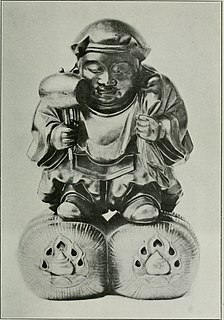 W
WDaikokuten is a syncretic Japanese deity of fortune and wealth. Daikokuten originated from Mahākāla, the Buddhist version of the Hindu deity Shiva, conflated with the native Shinto god Ōkuninushi.
 W
WDhṛtarāṣṭra is a major deity in Buddhism and one of the Four Heavenly Kings. His name means "Upholder of the Nation."
 W
WEbisu , also transliterated Webisu or called Hiruko (蛭子) or Kotoshiro-nushi-no-kami (事代主神), is the Japanese god of fishermen and luck. He is one of the Seven Gods of Fortune , and the only one of the seven to originate purely from Japan without any Buddhist or Taoist influence.
 W
WFūjin or Fūten (風天) is the Japanese god of the wind and one of the eldest Shinto gods. He is portrayed as a terrifying wizardly demon, resembling a red-headed green-skinned humanoid wearing a leopard skin, carrying a large bag of winds on his shoulders. In Japanese art, the deity is often depicted together with Raijin, the god of lightning, thunder and storms.
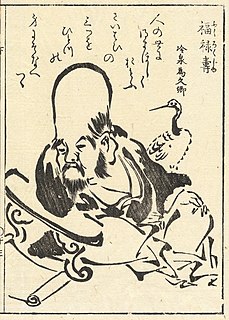 W
WIn Japan, Fukurokuju is one of the Seven Lucky Gods in Japanese mythology. It has been theorized that he is a Japanese assimilation of the Chinese Three Star Gods embodied in one deity. Most related in appearance to the Chinese star god Shou, he is the God of wisdom and longevity. According to some, before attaining divinity, he was a Chinese hermit of the Song Dynasty and a reincarnation of the Taoist Deity, Xuantian Shangdi. It is said that during his human incarnation, he was a sennin; a immortal who could exist without eating food.
 W
WFutodama is a god in Japanese mythology, claimed to be the ancestor of Imbe clan, whose characteristics are believed to reflect the functions of the clan as court ritualists.
 W
WFutsunushi , also known as Iwainushi , is a warrior god in Japanese mythology. Also known under the epithet Katori Daimyōjin (香取大明神) after his shrine in northern Chiba Prefecture, Katori Jingū, he is often revered alongside Takemikazuchi, with whom he is closely associated. He is regarded as a legendary ancestor of the Mononobe clan, and like Takemikazuchi is one of the tutelary deities of the Fujiwara clan.
 W
WGozu Tennō is a syncretic Japanese deity of disease and healing. Originally imported to Japan from mainland Asia, he was regarded since the Heian period both as a causer of and protector against epidemics and eventually became amalgamated with the native kami Susanoo during the medieval and early modern periods. During the Meiji period, when the government mandated the separation of Shinto and Buddhism, Shinto shrines dedicated to Gozu Tennō of the Gion cult tradition such as Yasaka Shrine in the Gion district of Kyoto or Tsushima Shrine in Tsushima, Aichi Prefecture officially reidentified their enshrined deity as Susanoo.
 W
WIn Japanese religion, Yahata formerly in Shinto and later commonly known as Hachiman is the syncretic divinity of archery and war, incorporating elements from both Shinto and Buddhism.
 W
WHoori , also known as Hikohohodemi no Mikoto (彦火火出見尊), is a figure in Japanese mythology, the third and youngest son of Ninigi-no-Mikoto and the blossom princess Konohanasakuya-hime. He is one of the ancestors of the Emperors of Japan as the grandfather of Emperor Jimmu. He is also known as Yamasachi-hiko (山幸彦).
 W
WIzanagi (イザナギ) or Izanaki (イザナキ) is a creator deity (kami) in Japanese mythology. He and his sister-wife Izanami are the last of the seven generations of primordial deities that manifested after the formation of heaven and earth. Izanagi and Izanami are held to be the creators of the Japanese archipelago and the progenitors of many deities, which include the sun goddess Amaterasu, the moon deity Tsukuyomi and the storm god Susanoo.
 W
WIn Japan, Jurōjin (寿老人) is one of the Seven Gods of Fortune or Shichifukujin, according to Taoist beliefs. He is the god of longevity. Jurōjin originated from the Chinese Taoist god, the Old Man of the South Pole. He is known as the immortal of the Northern Song dynasty (960–1127), and may have been a historical figure of the period. Jurōjin is identified as the personification of the Southern Polar Star. While paintings and statues of Jurōjin are considered auspicious, he never developed a following independent of the other deities Seven Gods of Fortune.
 W
WKangiten or Kankiten, also known as Binayaka, Ganabachi, or more commonly, Shōten or Shōden, is a deva (ten) venerated mainly in the Shingon and Tendai schools of Japanese Buddhism who is the Buddhist equivalent of the Hindu god Ganesha.
 W
WKōjin, also known as Sambō-Kōjin or Sanbō-Kōjin , is the Japanese kami (god) of fire, the hearth and the kitchen. He is sometimes called Kamado-gami, literally the god of the stove. He represents violent forces that are turned toward the betterment of humankind.
 W
WKonpira Gongen (金毘羅権現) is a Japanese god of the Shugendō sect originating in the mountain Kotohira of Kagawa Prefecture. He is the god of merchant sailors.
 W
WKuebiko (久延毘古) is the Shinto kami of Folk wisdom, knowledge and agriculture, and is represented in Japanese mythology as a scarecrow who cannot walk but has comprehensive awareness.
 W
WKumanokusubi is a God in Japanese mythology. He is the fifth son of Amaterasu.
 W
WKunado-no-Kami, alternately Kunato-no-Kami, Funado-no-Kami, Funato-no-Kami, or Chimata-no-Kami, are Japanese local gods connected chiefly with protection against disaster and malicious spirits.
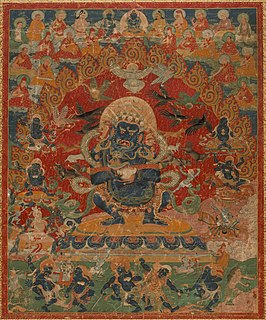 W
WMahākāla is a deity common to Hinduism and Tantric Buddhism. In Buddhism, Mahākāla is a fierce form of Vishnu, While in Hinduism, Mahākāla is a fierce manifestation of both Shiva and Vishnu (Narasimha), and is the consort of the goddess Mahākālī; he most prominently appears in the Kalikula sect of Shaktism. Mahākāla also appears as a protector deity known as a dharmapala in Vajrayana, Chinese Esoteric, and Tibetan Buddhism, and also in the Chàn and Shingon traditions. He is known as Dàhēitiān and Daaih'hāktīn in Mandarin and Cantonese, Daeheukcheon (대흑천) in Korean, Đại Hắc Thiên in Vietnamese, and Daikokuten in Japanese.
 W
WMatara-jin (摩多羅神) is a Buddhist god from the Tendai school of Japanese Buddhism. Through history he was closely associated with the Mt. Hiei temple complex. He was commonly worshiped in an area called ushirodo in Tendai temples.
 W
WMizuhanome is a God in Japanese mythology. She is a kami of water. She was born from the urine of Izanami.
 W
WMyōken, also known as Sonjō-Ō, is a Buddhist deification of the North Star worshiped mainly in the Shingon, Tendai and Nichiren schools of Japanese Buddhism.
 W
WNinigi-no-Mikoto is a deity in Japanese mythology. Grandson of the sun goddess Amaterasu, Ninigi is the great-grandfather of Japan’s first emperor, Emperor Jimmu. His descent from Heaven brought rice and order to earth. The three sacred treasures brought with Ninigi from Heaven and divine ancestry established the Japanese Imperial Family.
 W
WNiō (仁王) are two wrathful and muscular guardians of the Buddha standing today at the entrance of many Buddhist temples in East Asian Buddhism in the form of frightening wrestler-like statues. They are dharmapala manifestations of the bodhisattva Vajrapāṇi, the oldest and most powerful of the Mahayana Buddhist pantheon. According to scriptures like the Pāli Canon as well as the Ambaṭṭha Sutta, they travelled with Gautama Buddha to protect him. Within the generally pacifist tradition of Buddhism, stories of dharmapalas justified the use of physical force to protect cherished values and beliefs against evil. They are also seen as a manifestation of Mahasthamaprapta, the bodhisattva of power that flanks Amitābha in Pure Land Buddhism and as Vajrasattva in Tibetan Buddhism.
 W
WŌkuninushi, also known as Ō(a)namuchi or Ō(a)namochi among other variants, is a kami in Japanese mythology. He is one of the central deities in the cycle of myths recorded in the Kojiki and the Nihon Shoki alongside the sun goddess Amaterasu and her brother, the wild god Susanoo, who is reckoned to be either Ōkuninushi's distant ancestor or father. In these texts, Ōkuninushi (Ōnamuchi) is portrayed as the head of the kunitsukami, the gods of the earth, and the original ruler of the terrestrial world, named Ashihara-no-Nakatsukuni. When the heavenly deities (amatsukami) headed by Amaterasu demanded that he relinquish his rule over the land, Ōkuninushi agreed to their terms and withdrew into the unseen world, which was given to him to rule over in exchange. Amaterasu's grandson Ninigi then came down from heaven to govern Ashihara-no-Nakatsukuni and eventually became the ancestor of the Japanese imperial line.
 W
WOmoikane is a Shinto god of wisdom and intelligence. His name means "serving one's thoughts." A heavenly deity who is called upon to "ponder" and give good counsel in the deliberations of the heavenly deities. In the myth where Amaterasu hid in a cave, he was tasked to find a way to get her out.
 W
WŌyama-tsumi or Ohoyama-tsumi is a god of mountains, sea, and war in Japanese mythology. He is an elder brother of Amaterasu and Susanoo. His other names are Watashi-no-Ōkami (和多志大神) and Sakatoke (酒解神).
 W
WRāgarāja is a deity venerated in the Esoteric and Vajrayana Buddhist traditions. He is especially revered in Chinese Esoteric Buddhism in Chinese communities as well as Shingon and Tendai in Japan.
 W
WRaijin , also known as Kaminari-sama (雷様), Raiden-sama (雷電様), Narukami (鳴る神) Raikou (雷公), and Kamowakeikazuchi-no-kami is a god of lightning, thunder and storms in Japanese mythology and the Shinto religion. He is typically depicted with fierce and aggressive facial expressions, standing atop a cloud, beating on drums with tomoe symbols drawn on them. Iconography of Raijin are often found in Japanese temples and shrines. He is usually depicted alongside Fūjin, the god of wind.
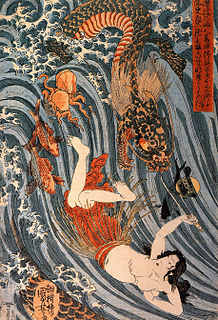 W
WRyūjin, which in some traditions is equivalent to Ōwatatsumi, was the tutelary deity of the sea in Japanese mythology. In many versions Ryūjin had the ability to transform into a human shape. Many believed the god had knowledge on medicine and many considered him as the bringer of rain and thunder, Ryujin is also the patron god (ujigami) of several family groups.
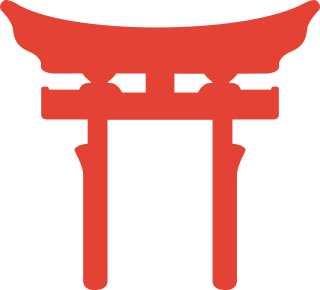 W
WSarutahiko Ōkami is a deity of the Japanese religion of Shinto; he is the leader of the earthly kami. Norito also mentions him with the title Daimyōjin instead of Ōkami . Sarutahiko Ōkami was the head of the kunitsukami.
 W
WSōjōbō is the mythical king and god of the tengu. In Japanese folklore and mythology, the tengu are legendary creatures thought to inhabit the mountains and forests of Japan. Sōjōbō is a specific type of tengu called daitengu and has the appearance of a yamabushi, a Japanese mountain hermit. Daitengu have a primarily human form with some bird-like features such as wings and claws. The other distinctive physical characteristics of Sōjōbō include his long, white hair and unnaturally long nose.
 W
WSukunabikona or Sukuna bikona is the Shinto kami of the onsen, agriculture, healing, magic, brewing sake and knowledge. His name means "the small lord of renown." He is often described as being a dwarf and is frequently paired with Ōkuninushi.
 W
WTakemikazuchi (建御雷/武甕槌) is a deity in Japanese mythology, considered a god of thunder and a sword god. He also competed in what is considered the first sumo wrestling match recorded in history.
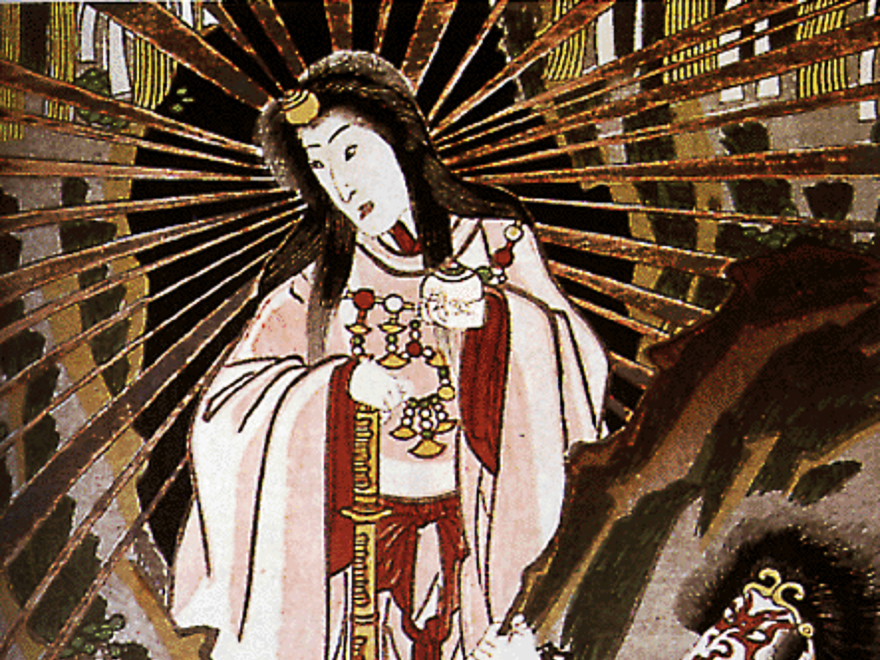 W
WTengu are a type of legendary creature found in Japanese folk religion. They are considered a type of yōkai or Shinto kami (gods). The tengu were originally thought to take the forms of birds of prey and monkey deity, and they are traditionally depicted with human, monkey and avian characteristics. Sarutahiko Ōkami is considered to be the original model of Konoha-Tengu, which today is widely considered the tengu's defining characteristic in the popular imagination. He is the Shinto monkey deity who sheds light on heaven and earth. Some experts theorize that Sarutahiko was a sun god worshiped in Ise region prior to the popularization of Amaterasu.
 W
WIn the Shinto religion of Japan, Tenjin (天神) is the patron kami (deity) of academics, scholarship, of learning, and of the intelligentsia.
 W
WUgayafukiaezu no Mikoto (鵜葺草葺不合命) is a Shinto kami, and is in Japanese mythology, the father of Japan's first Emperor, Emperor Jimmu.
 W
WVajrayakṣa is one of the Five Wisdom Kings. He is a manifestation of Amoghasiddhi.
 W
WIn East Asian and Buddhist mythology, Yama or Yanluo Wang/King Yamla, also known as King Yan/King Yam, Grandfatherly King Yan, Lord Yan, and Yama, Son of Heaven, is the King of Hell and a dharmapala said to judge the dead and preside over the Narakas and the cycle of afterlife saṃsāra.